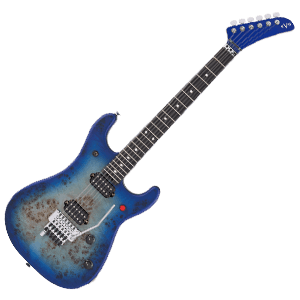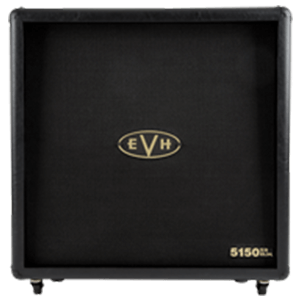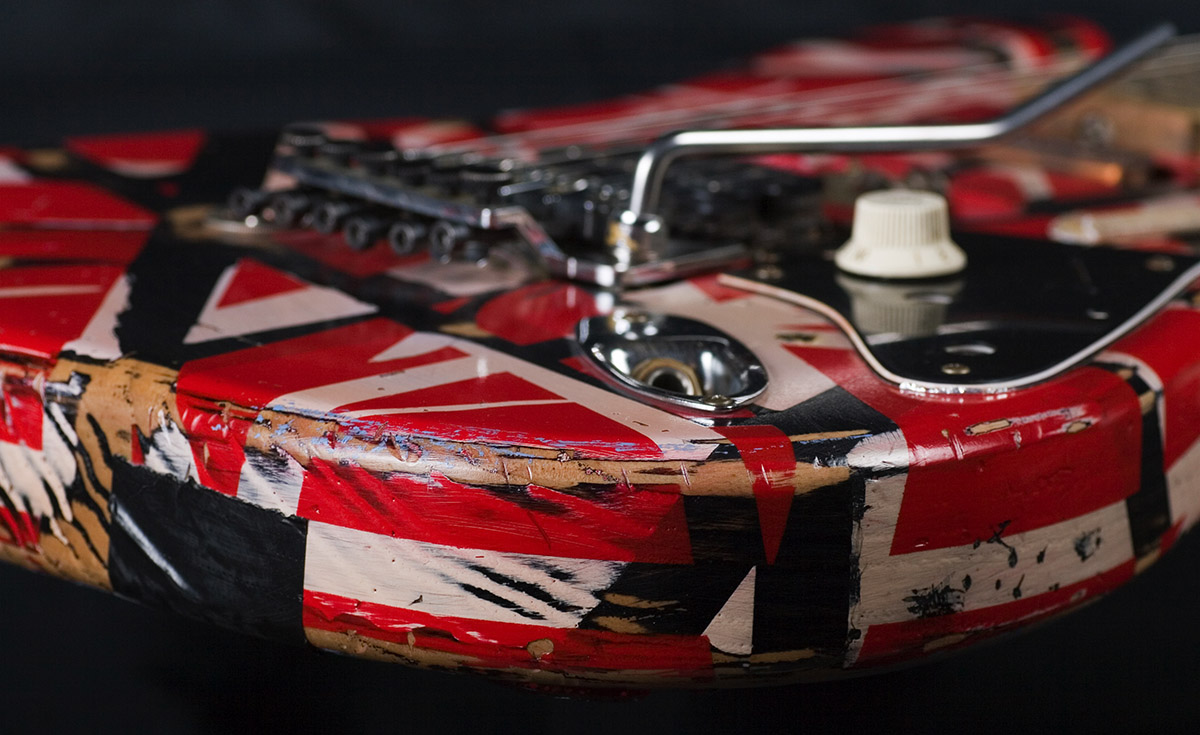
Who Is That Guy?
Seldom if ever in the history of rock—in the history of guitar playing, period, for that matter—can monumental change be attributed to one person; to a single guitarist whose own individual contributions amount to nothing short of an astounding re-imagining of the instrument’s possibilities and whose playing abilities and innovations are so utterly dazzling as to be considered truly revolutionary. Such is the case with Edward Van Halen.

He exploded onto the music scene in the late ’70s and, seemingly overnight, rewrote the book on rock guitar as few if any had done before. How did he play like that? How did he get those sounds? And what was that weird guitar he was playing? This was something new; a wild, ambitiously swaggering rock band from Los Angeles that boasted a skinny, smiling 20-something kid who was so utterly musically ferocious that you were left with no choice. And to truly start to appreciate the shock waves he sent shuddering through the guitar world, it is to that late ’70s era you must return.
If you were a rock guitarist in the late 1970s, you and everybody else were no doubt riffing away happily—pentatonically, mostly—on one of the popular mainstream electric guitar models of the day. Then, on Feb. 10, 1978, Van Halen was released. And your world was no longer the same—you either got on this new rocket, or you were over.
Nobody had ever seen or heard anything like Eddie Van Halen. Nobody had ever seen or heard the strange guitar he worked his magic with. With this striking black-and-white striped guitar, he dazzlingly swooped, dived, screamed and blazed his innovative way through one of the most original and most famous debut albums in history. No overdubs. No huge pedalboards. No fancy and expensive custom gear. A lucky few knew what was coming because they’d watched and listened awestruck in the early days as he routinely reduced the Sunset Strip nightclubs to smoldering piles of rubble with his guitar. Some established guitar heroes laughed at his duct-taped-home-made stage setup when the still-fledgling Van Halen opened for them, but they weren’t laughing when the show was over and Eddie had won the room and left audience’s jaws somewhere around their ankles.

His dazzling technique was incredibly acrobatic, which had the added benefit of being not only sonically adventurous, but also riveting to watch onstage. And yet it wasn’t about acrobatics—to assume so was to miss the point. Those who mistook Eddie for a mere gymnast failed to grasp this central truth of his playing. While he inspired armies of would-be imitators, none lasted long.
Whatever he did with his guitar and with his hands was always for the song. Whatever he played and however he played it, it was in the service of a great song, and whatever he did, he did it with absolute grace, taste, class, and devotion to musicianship, a central truth of his artistry borne out by the fact that whereas pale imitators quickly came and went, Eddie Van Halen wrote and played hit after hit after hit: “Jamie’s Cryin’.” “You Really Got Me,” “Dance the Night Away.” “Beautiful Girls.” “Cradle Will Rock.” “(Oh) Pretty Woman.” “Jump.” “Hot For Teacher.” “Panama.” “Why Can’t This Be Love?” “When It’s Love.” “Finish What Ya Started.” “Right Now.” We could go on and on.
Eddie Van Halen wasn’t just at the epicenter of the new rock guitar. He was the epicenter. Ironic as it seems, he was actually a thoughtfully quiet kind of guy when he wasn’t busy onstage redefining the genre and melting everybody’s faces off. Sure, his band had macho swagger to spare, but it was always delivered with a wink and a smile. Unlike most at the time, Van Halen the band was not mean, not brooding or dark. Just watch any Van Halen video or concert footage—unlike many of his solemn, sneering contemporaries, Eddie Van Halen was smiling the whole time; enjoying the hell out of what he did while he blew you away. Eddie made it fun.
A New Take on a Classic Guitar
Look at the cover of the first album, Van Halen. Look at that guitar, the black-and-white (later red) striped instrument that 22-year-old Eddie Van Halen (the album was released two weeks after his 23rd birthday) is thrusting toward the camera like he’s showing you the future, and realize that this monumental instrument quickly became an icon that remains perhaps the world’s most instantly recognizable guitar. Realize also that when this trailblazing album first appeared, nobody had ever seen or heard a guitar like that because no such guitar ever existed. What was this? You couldn’t buy one.

That’s because he made it himself. Eddie Van Halen, you see, had the mind of not only a great musician, but also of an innovative inventor—a constant tinkerer who was always messing with his gear; always trying this and that—sometimes destroying this and that—and always after something that you couldn’t just walk into any old guitar store and buy.
He couldn’t help it. No off-the-shelf guitar had the features he needed to really let his playing take off, and he knew it. He’d tried a few staples in his formative years, but eventually found them all lacking in one way or another. So he took matters into his own capable hands.
The irony of it was that he wasn’t a guitar geek. He didn’t know how to wire; he hadn’t studied guitar design. He was resourceful, creative and innovative; a free thinker unencumbered by tradition who didn’t follow the rules because he didn’t know the rules. During the relatively short period in his career when was not yet a household name, this served him well as he acquired parts and honed ideas for his own distinctive creation.
And what a creation it turned out to be. The guitar that appears on the cover of Van Halen was Eddie’s first “super guitar.” He bought a factory-second guitar body for $50 and a neck for $80, made in 1975. This new guitar body came pre-routed for three single-coil pickups, so Van Halen took up a chisel and soldering iron to install a fat-sounding humbucking pickup from an older semi-hollow body guitar, rotating it slightly to accommodate the wider string spacing of the original Fender bridge.

In an unintentional stroke of genius borne out of necessity, Eddie conceived of the idea of dipping the humbucking pickup into an empty Yuban coffee can full of molten paraffin wax to reduce feedback once the wax cooled and solidified (“The same kind of wax that you use to wax a surfboard,” he told Guitar Player magazine in 1979), a technique now known as “potting” a pickup. He also adjusted the vibrato bridge plate to lie flat against the body, preventing upward bends while increasing tuning stability. Also to his preference, the unfinished neck was wider and flatter; Eddie also replaced the original frets with larger fret wire.
It was this guitar body that first received the distinctive and soon-to-be-iconic striped paint job; Van Halen sprayed it with black and white Schwinn® acrylic lacquer bicycle paint. He cut out and mounted his own homemade black pickguard, covering the neck and middle pickup routings, and installed a single master volume knob (although the knob itself, famously, was a “Tone” knob), brass nut and an original Fender tremolo tailpiece.
Although it didn’t take long to build, and although the whole shebang cost him less than $150, this was the guitar that would change the world. He played “Eruption” on this guitar. Fantastic, timeless music was made with this guitar. It became Van Halen’s main instrument for the first several albums and tours, and he soon striped it one last time and added a top coat of red; with the addition of orange and red truck reflectors, Eddie was now complete in creating one of the most iconic guitars in rock ‘n’ roll history.
During Van Halen’s second world tour, he replaced the original tremolo with an odd device—a prototype locking tremolo system built by Seattle designer Floyd Rose. To fill the gap between the top surface of the guitar body and the bottom side of the tremolo plate, Eddie’s modest-but-efficient solution was to permanently mount a quarter under the unit’s top-back side. A succession of replacement necks all maintained the use of Schaller® tuners after Van Halen broke the original neck.
Fans loved the guitar and what he did with it. They even gave it a nickname—“Frankenstein™.” Indeed, it’s worth noting that it was never Eddie who called the guitar by that name; it was his legions of devoted fans. Who else had a guitar so popular that fans actually named it?
To Eddie, it was simply “My baby.”
Fast Forward to 2007
Like all true innovators, Eddie Van Halen continuously evolved. As he changed, his style and his arsenal changed. Listen to 1978’s Van Halen, then listen to 1995’s Balance; listen to “Ain’t Talkin’ ’Bout Love, then listen to “Right Now.” His playing is as amazing now as it ever was, but his devotion to artistry, musicianship and songcraft has grown and matured all along the way since his first groundbreaking record and those first raucous tours.
He eventually reached a point where he decided to share his legacy of innovation with guitarists everywhere by offering a first-rate replica of that first incredible guitar, a faithful recreation of that monumental and absolutely unmistakable instrument. He had embarked before on various projects for various models with various makers, but for a never-before-produced truly faithful recreation of the instrument so dear to him personally and revered by fans worldwide as Frankenstein™, he knew there was only one company he could do it with. Fender.
It makes sense. One innovator joining forces with another. An artist and a company with a history and a tradition of pioneering greatness.
So in 2007, Eddie Van Halen and the master builders of the Fender Custom Shop in Corona, Calif., joined forces to bring you EVH® brand guitars, amps and musical products, beginning with a most eagerly awaited musical event: the unveiling of a very special 300-instrument limited edition run of the Eddie Van Halen Frankenstein™ replica guitar — an astoundingly and painstakingly accurate rendition of what is widely regarded as the world’s most recognizable electric guitar.
This red, black and white striped ash-body guitar features a bolt-on maple neck, and was put through an astounding aging process to replicate the effects of the explosive years Eddie Van Halen spent on the road with the original. No effort was spared to mirror every last scratch, ding and cigarette burn; Fender designers even scoured the land for 1971 quarters (that’s the right year), just like the original he at one time stuck under the original tremolo bridge. While Eddie no longer uses the quarter for that purpose, it’s still one of the guitar’s most recognizable appointments, and still adorns Ed’s baby, as well as each and every Frankenstein replica guitar.
The guitar also has a Seymour Duncan® Custom Shop EVH® humbucking pickup, with a single master volume knob (that says “Tone”) mounted on a single-ply partial black pickguard, identical to the original. Other features include Schaller® tuners, aged chrome hardware, and a limited edition, fully “relic-ed” EVH® road case. Leaving no stone unturned, the guitar is complete with a non-functional three-way switch and single-coil pickup that occupy two of the three pickup routs.
A phenomenally crafted piece of rock history—of guitar history, period&mdash, the Frankeinstein™ Replicat Tribute model re-evokes the awestruck wonder and sheer thrill you experienced the first time you saw, heard and felt the incredible musical power of Eddie Van Halen.
After all, it’s his baby.
Frankenstein™ Replica Tribute


















